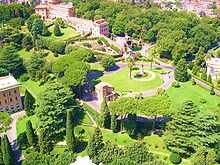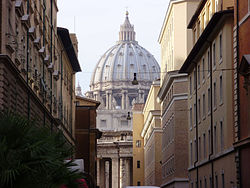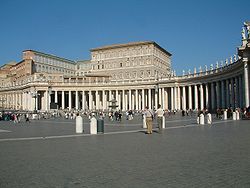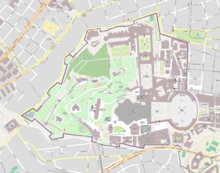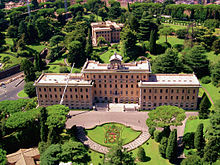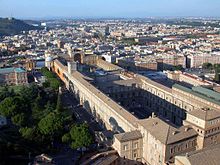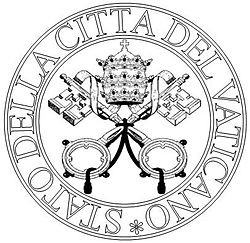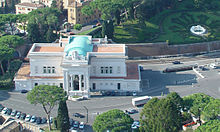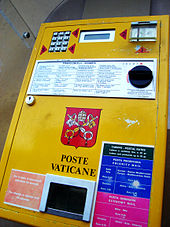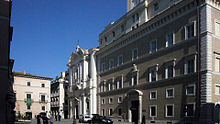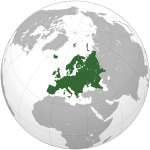- Vatican City
-
Vatican City State[1] Stato della Città del Vaticano[2]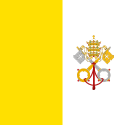

Flag Coat of arms Anthem: "Inno e Marcia Pontificale" (Italian)
"Pontifical Anthem and March"Location of Vatican City (green)in Europe (dark grey) — [Legend]
Capital Vatican City[3]
41°54.2′N 12°27.2′E / 41.9033°N 12.4533°EOfficial language(s) Italian[4] Latin[5] Ethnic groups Italians, Swiss (Swiss Guards), other[6] Government ecclesiastical,[6]
sacerdotal-monarchical,[7]
Absolute and elective monarchy[8]- Sovereign Benedict XVI - President of the Governorate Giuseppe Bertello Legislature Pontifical Commission Independence from the Kingdom of Italy - Lateran Treaty 11 February 1929 Area - Total 0.44 km2 (236th)
0.17 sq miPopulation - July 2010 estimate 829[9] (223rd) - Density 1877/km2 (6th)
4,859/sq miCurrency Euro (€)[10][11] ( EUR)Time zone CET (UTC+1) - Summer (DST) CEST (UTC+2) Drives on the right[note 1] Internet TLD .va Calling code +379[12] Vatican City
 i/ˈvætɨkən ˈsɪti/, or Vatican City State,[13] in Italian officially Stato della Città del Vaticano (pronounced [ˈstaːto della t͡ʃitˈta del vatiˈkaːno]),[14] which translates literally as State of the City of the Vatican, is a landlocked sovereign city-state whose territory consists of a walled enclave within the city of Rome, Italy. It has an area of approximately 44 hectares (110 acres), and a population of just over 800.[6][15]
i/ˈvætɨkən ˈsɪti/, or Vatican City State,[13] in Italian officially Stato della Città del Vaticano (pronounced [ˈstaːto della t͡ʃitˈta del vatiˈkaːno]),[14] which translates literally as State of the City of the Vatican, is a landlocked sovereign city-state whose territory consists of a walled enclave within the city of Rome, Italy. It has an area of approximately 44 hectares (110 acres), and a population of just over 800.[6][15]Vatican City was established in 1929 by the Lateran Treaty, signed by Cardinal Secretary of State Pietro Gasparri, on behalf of the Holy See and by Prime Minister Benito Mussolini on behalf of the Kingdom of Italy. Vatican City State is distinct from the Holy See, which dates back to early Christianity and is the main episcopal see of 1.2 billion Latin and Eastern Catholic adherents around the globe. Ordinances of Vatican City are published in Italian; official documents of the Holy See are issued mainly in Latin. The two entities have distinct passports: the Holy See, not being a country, issues only diplomatic and service passports, whereas Vatican City State issues normal passports. In each case very few passports are issued.
The Lateran Treaty in 1929, which brought the city-state into existence, spoke of it as a new creation (Preamble and Article III), not as a vestige of the much larger Papal States (756–1870) that had previously encompassed much of central Italy. Most of this territory was absorbed into the Kingdom of Italy in 1860, and the final portion, namely the city of Rome with Lazio, ten years later, in 1870.
Vatican City is an ecclesiastical[6] or sacerdotal-monarchical[7] state, ruled by the Bishop of Rome—the Pope. The highest state functionaries are all Catholic clergymen of various national origins. It is the sovereign territory of the Holy See (Sancta Sedes) and the location of the Pope's residence, referred to as the Apostolic Palace.
The Popes have generally resided in the area that in 1929 became Vatican City since the return from Avignon in 1377, but have also at times resided in the Quirinal Palace in Rome and elsewhere. Previously, they resided in the Lateran Palace on the Caelian Hill on the far side of Rome from the Vatican. Emperor Constantine gave this site to Pope Miltiades in 313. The signing of the agreements that established the new state took place in the latter building, giving rise to the name of Lateran Pacts, by which they are known.
Contents
Geography
Main article: Geography of Vatican CityThe Vatican climate is the same as Rome's; a temperate, Mediterranean climate with mild, rainy winters from September to mid-May and hot, dry summers from May to August. There are some local features, principally mists and dews, caused by the anomalous bulk of St Peter's Basilica, the elevation, the fountains and the size of the large paved square.
The Vatican City is the world's smallest state, being only around 44 ha (110 acres).
In July 2007, the Vatican agreed to become the first carbon neutral state. They plan to accomplish this by offsetting carbon dioxide emissions with the creation of a Vatican Climate Forest in Hungary.[16]
Territory
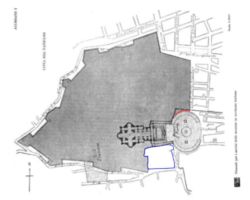 Territory of Vatican City according to the Lateran Treaty
Territory of Vatican City according to the Lateran Treaty
The name "Vatican" predates Christianity and comes from the Latin Mons Vaticanus, meaning Vatican Mount.[17] The territory of Vatican City is part of the Mons Vaticanus, and of the adjacent former Vatican Fields. It is in this territory that St. Peter's Basilica, the Apostolic Palace, the Sistine Chapel, and museums were built, along with various other buildings. The area was part of the Roman rione of Borgo until 1929. Being separated from the city, on the west bank of the Tiber river, the area was an outcrop of the city that was protected by being included within the walls of Leo IV (847–55), and later expanded by the current fortification walls, built under Paul III (1534–49), Pius IV (1559–65) and Urban VIII (1623–44).
When the Lateran Treaty of 1929 that gave the state its present form was being prepared, the boundaries of the proposed territory were influenced by the fact that much of it was all but enclosed by this loop. For some tracts of the frontier, there was no wall, but the line of certain buildings supplied part of the boundary, and for a small part of the frontier a modern wall was constructed.
The territory includes St. Peter's Square, distinguished from the territory of Italy only by a white line along the limit of the square, where it touches Piazza Pio XII. St. Peter's Square is reached through the Via della Conciliazione which runs from close to the Tiber River to St. Peter's. This grand approach was constructed by Benito Mussolini after the conclusion of the Lateran Treaty.
According to the Lateran Treaty, certain properties of the Holy See that are located in Italian territory, most notably Castel Gandolfo and the major basilicas, enjoy extraterritorial status similar to that of foreign embassies.[18][19] These properties, scattered all over Rome and Italy, house essential offices and institutions necessary to the character and mission of the Holy See.[19] Castel Gandolfo and the named basilicas are patrolled internally by police agents of Vatican City State and not by Italian police. St. Peter's Square is ordinarily policed jointly by both.[18]
Gardens
Main article: Gardens of Vatican CityWithin the territory of Vatican City are the Vatican Gardens (Italian: Giardini Vaticani),[20] which account for more than half of this territory. The gardens, established during the Renaissance and Baroque era, are decorated with fountains and sculptures.
The gardens cover approximately 23 hectares (57 acres) which is most of the Vatican Hill. The highest point is 60 metres (200 ft) above mean sea level. Stone walls bound the area in the North, South and West.
The gardens date back to medieval times when orchards and vineyards extended to the north of the Papal Apostolic Palace.[21] In 1279 Pope Nicholas III (Giovanni Gaetano Orsini, 1277–1280) moved his residence back to the Vatican from the Lateran Palace and enclosed this area with walls.[22] He planted an orchard (pomerium), a lawn (pratellum) and a garden (viridarium).[22]
History
Vatican City * UNESCO World Heritage Site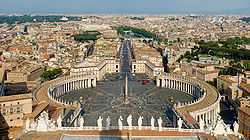
Country Holy See Type Cultural Criteria i, ii, iv, vi Reference 286 Region ** Europe Inscription history Inscription 1984 (8th Session) * Name as inscribed on World Heritage List
** Region as classified by UNESCOPredecessor states
Main articles: Papal States and History of the PapacyIn this originally uninhabited area (the ager vaticanus) on the opposite side of the Tiber from the city of Rome, Agrippina the Elder (14 BC – 18 October AD 33) drained the hill and environs and built her gardens in the early 1st century AD. Emperor Caligula (31 August AD 12 – 24 January AD 41; r. 37–41) started construction of a circus (AD 40) that was later completed by Nero, the Circus Gaii et Neronis,[23] usually called, simply, the Circus of Nero. In AD 69, the Year of the Four Emperors, when the northern army that brought Aulus Vitellius to power arrived in Rome, "a large proportion camped in the unhealthy districts of the Vatican, which resulted in many deaths among the common soldiery; and the Tiber being close by, the inability of the Gauls and Germans to bear the heat and the consequent greed with which they drank from the stream weakened their bodies, which were already an easy prey to disease".[24]
The Vatican obelisk was originally taken by Caligula from Heliopolis, Egypt to decorate the spina of his circus and is thus its last visible remnant. This area became the site of martyrdom of many Christians after the Great Fire of Rome in AD 64. Ancient tradition holds that it was in this circus that Saint Peter was crucified upside-down.
Opposite the circus was a cemetery separated by the Via Cornelia. Funeral monuments and mausoleums and small tombs as well as altars to pagan gods of all kinds of polytheistic religions were constructed lasting until before the construction of the Constantinian Basilica of St. Peter's in the first half of the 4th century. Remains of this ancient necropolis were brought to light sporadically during renovations by various popes throughout the centuries increasing in frequency during the Renaissance until it was systematically excavated by orders of Pope Pius XII from 1939 to 1941.
In 326, the first church, the Constantinian basilica, was built over the site that early Roman Catholic apologists (from the first century on) as well as noted Italian archaeologists argue was the tomb of Saint Peter, buried in a common cemetery on the spot. From then on the area started to become more populated, but mostly only by dwelling houses connected with the activity of St. Peter's. A palace was constructed near the site of the basilica as early as the 5th century during the pontificate of Pope Symmachus (reigned 498–514).[25]
Popes in their secular role gradually came to govern neighbouring regions and, through the Papal States, ruled a large portion of the Italian peninsula for more than a thousand years until the mid 19th century, when all of the territory of the Papal States was seized by the newly created Kingdom of Italy. For much of this time the Vatican was not the habitual residence of the Popes, but rather the Lateran Palace, and in recent centuries, the Quirinal Palace, while the residence from 1309–77 was at Avignon in France.
Italian unification
Main article: Roman QuestionView of the dome of Saint Peter's Basilica from Borgo Santo Spirito.
In 1870, the Pope's holdings were left in an uncertain situation when Rome itself was annexed by the Piedmont-led forces which had united the rest of Italy, after a nominal resistance by the papal forces. Between 1861 and 1929 the status of the Pope was referred to as the "Roman Question". The successive Popes were undisturbed in their palace, and certain prerogatives recognized by the Law of Guarantees, including the right to send and receive ambassadors. But the Popes did not recognise the Italian king's right to rule in Rome, and they refused to leave the Vatican compound until the dispute was resolved in 1929. Other states continued to maintain international recognition of the Holy See as a sovereign entity.
In practice Italy made no attempt to interfere with the Holy See within the Vatican walls. However, they confiscated church property in many other places, including, perhaps most notably, the Quirinal Palace, formerly the pope's official residence. Pope Pius IX (1846–78), the last ruler of the Papal States, claimed that after Rome was annexed he was a "Prisoner in the Vatican".
Lateran treaties
Main article: Lateran TreatyThe Apostolic Palace.
This situation was resolved on 11 February 1929 between the Holy See and the Kingdom of Italy. The Lateran Treaty was signed by Benito Mussolini on behalf of King Victor Emmanuel III and by Cardinal Secretary of State Pietro Gasparri for Pope Pius XI. The treaty, which became effective on 7 June 1929, and the Concordat established the independent State of the Vatican City and granted Roman Catholicism special status in Italy.
World War II
Main article: Vatican City during World War IIVatican City officially pursued a policy of neutrality during World War II, under the leadership of Pope Pius XII. Although the city of Rome was occupied by Germany from 1943 and the Allies from 1944, Vatican City itself was not occupied. One of Pius XII's main diplomatic priorities was to prevent the bombing of Rome; so sensitive was the pontiff that he protested even the British air dropping of pamphlets over Rome, claiming that the few landing within the city-state violated the Vatican's neutrality.[26] Before the American entry into the war, there was little impetus for such a bombing, as the British saw little strategic value in it.[27]
After the American entry, the US opposed such a bombing, fearful of offending Catholic members of its military forces, while the British then supported it.[28] Pius XII similarly advocated for the declaration of Rome as an "open city", but this occurred only on 14 August 1943, after Rome had already been bombed twice.[29] Although the Italians consulted the Vatican on the wording of the open city declaration, the impetus for the change had little to do with the Vatican.[30]
Recent history
In 1984, a new concordat between the Holy See and Italy modified certain provisions of the earlier treaty, including the position of Roman Catholicism as the Italian state religion.
Governance
Vatican City State 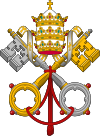
This article is part of the series:
Politics and government of
Vatican City State- Fundamental Law
- Pope: Benedict XVI
- Pontifical Commission
- Secretariat of State
- Conclave: 2005
- Apostolic Signatura
- Roman Rota
- Foreign relations
- Military
- Vicar General
- Financial Information Authority
Main article: Politics of Vatican CityThe politics of Vatican City takes place in an absolute elective monarchy, in which the head of the Roman Catholic Church takes power. The Pope exercises principal legislative, executive, and judicial power over the State of Vatican City (an entity distinct from the Holy See), which is a rare case of a non-hereditary monarchy.[31]
Vatican City is currently the only widely recognised independent state that has not become a member of the UN. The Holy See, which is distinct from Vatican City State, has permanent observer status with all the rights of a full member except for a vote in the UN General Assembly.
Political system
The government of Vatican City has a unique structure. The Pope is the sovereign of the state. Legislative authority is vested in the Pontifical Commission for Vatican City State, a body of cardinals appointed by the Pope for five-year periods. Executive power is in the hands of the President of that commission, assisted by the General Secretary and Deputy General Secretary. The state's foreign relations are entrusted to the Holy See's Secretariat of State and diplomatic service. Nevertheless, the pope has full and absolute executive, legislative and judicial power over Vatican City. He is currently the only absolute monarch in Europe.
There are specific departments that deal with health, security, telecommunications, etc.[32]
The Cardinal Camerlengo presides over the Apostolic Camera to which is entrusted the administration of the property and the protection of the temporal rights of the Holy See during a papal vacancy. Those of the Vatican State remain under the control of the Pontifical Commission for the State of Vatican City. Acting with three other cardinals chosen by lot every three days, one from each order of cardinals (cardinal bishop, cardinal priest, and cardinal deacon), he in a sense performs during that period the functions of head of state. All the decisions these four cardinals take must be approved by the College of Cardinals as a whole.
The nobility that was closely associated with the Holy See at the time of the Papal States continued to be associated with the Papal Court after the loss of these territories, generally with merely nominal duties (see Papal Master of the Horse, Prefecture of the Pontifical Household, Hereditary officers of the Roman Curia, Black Nobility). They also formed the ceremonial Noble Guard. In the first decades of the existence of the Vatican City State, executive functions were entrusted to some of them, including that of Delegate for the State of Vatican City (now denominated President of the Commission for Vatican City). But with the motu proprio Pontificalis Domus of 28 March 1968,[33] Pope Paul VI abolished the honorary positions that had continued to exist until then, such as Quartermaster General and Master of the Horse.[34]
The State of the Vatican City, created in 1929 by the Lateran Pacts, provides the Holy See with a temporal jurisdiction and independence within a small territory. It is distinct from the Holy See. The state can thus be deemed a significant but not essential instrument of the Holy See. The Holy See itself has existed continuously as a juridical entity since Roman Imperial times and has been internationally recognised as a powerful and independent sovereign entity since late antiquity to the present, without interruption even at times when it was deprived of territory (e.g. 1870 to 1929). The Holy See has the oldest active continuous diplomatic service in the world, dating back to at least AD 325 with its legation to the Council of Nicea.[35] Ambassadors are accredited to the Holy See, never to the Vatican City State.
Head of state
Main article: PopeThe Pope is ex officio head of state[36] of Vatican City, functions dependent on his primordial function as bishop of the diocese of Rome. The term Holy See refers not to the Vatican state but to the Pope's spiritual and pastoral governance, largely exercised through the Roman Curia.[37] His official title with regard to Vatican City is Sovereign of the State of the Vatican City.
His principal subordinate government official for Vatican City is the President of the Pontifical Commission for Vatican City State, who since 1952 exercises the functions previously belonging to the Governor of Vatican City. Since 2001, the President of the Pontifical Commission for Vatican City State also has the title of President of the Governorate of the State of Vatican City.
The Pope resides in the Papal Apartments of the Papal Palace overlooking off Saint Peter's Square. It is here he carries out his business and meets foreign representatives.
The current Pope is Benedict XVI, born Joseph Alois Ratzinger in Bavaria, Germany. Italian Cardinal Giovanni Lajolo serves as President of the Pontifical Commission for the State of Vatican City. He was appointed by Pope Benedict XVI on 11 September 2006.
Administration
Legislative functions are delegated to the unicameral Pontifical Commission for Vatican City State, led by the President of the Pontifical Commission for Vatican City State. Its seven members are cardinals appointed by the Pope for terms of five years. Acts of the commission must be approved by the pope, through the Holy See's Secretariat of State, and before taking effect must be published in a special appendix of the Acta Apostolicae Sedis. Most of the content of this appendix consists of routine executive decrees, such as approval for a new set of postage stamps.
Executive authority is delegated to the Governorate of Vatican City. The Governorate consists of the President of the Pontifical Commission—using the title "President of the Governorate of Vatican City"—a General Secretary, and a Vice General Secretary, each appointed by the pope for five year terms. Important actions of the Governorate must be confirmed by the Pontifical Commission and by the Pope through the Secretariat of State.
The Governorate oversees the central governmental functions through several departments and offices. The directors and officials of these offices are appointed by the pope for five year terms. These organs concentrate on material questions concerning the state's territory, including local security, records, transportation, and finances. The Governorate oversees a modern security and police corps, the Corpo della Gendarmeria dello Stato della Città del Vaticano.
Judicial functions are delegated to a supreme court, an appeals court, a tribunal, and a trial judge. In all cases, the pope may choose at any time to exercise supreme legislative, executive, or judicial functions in the state.
The Country code prefix is SCV, and the only postal code is 00120 – altogether SCV-00120.[38]
Military and police
Main article: Military of Vatican CityThough, like various European powers, earlier Popes recruited Swiss mercenaries as part of an army, the Pontifical Swiss Guard was founded by Pope Julius II on 22 January 1506 as the personal bodyguard of the Pope and continues to fulfil that function. It is listed in the Annuario Pontificio under "Holy See", not under "State of Vatican City". At the end of 2005, the Guard had 134 members. Recruitment is arranged by a special agreement between the Holy See and Switzerland. All recruits must be Catholic, unmarried males with Swiss citizenship who have completed their basic training with the Swiss Army with certificates of good conduct, be between the ages of 19 and 30, and be at least 175 cm (68.90 in) in height. Members are armed with small arms and the traditional halberd (also called the Swiss voulge), and trained in bodyguarding tactics.
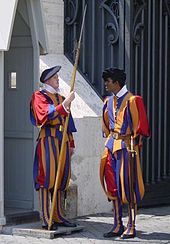 Swiss Guards in their traditional uniform
Swiss Guards in their traditional uniform
The Palatine Guard and the Noble Guard were disbanded by Pope Paul VI in 1970.[39] While the first body was founded as a militia at the service of the Papal States, its functions within the Vatican State, like those of the Noble Guard, were merely ceremonial.
The Corpo della Gendarmeria acts as a police force. Its full name is Corpo della Gendarmeria dello Stato della Città del Vaticano (which means "Gendarmerie Corps of the Vatican City State"), although it is sometimes referred to as the Vigilanza, as a shortening of an earlier name. The Gendarmeria is responsible for public order, law enforcement, crowd and traffic control, and criminal investigations in Vatican City.[39]
The military defence of the Vatican City is provided by Italy and its armed forces, given the fact that Vatican City is an enclave within the Italian Republic. Vatican City has no armed force of its own, the Swiss Guard being a corps responsible for the security of the Pope.
Foreign relations
See also: Foreign relations of the Holy SeeVatican City State is a recognised national territory under international law, but it is the Holy See that conducts diplomatic relations on its behalf, in addition to the Holy See's own diplomacy, entering into international agreements in its regard. The Vatican City State thus has no diplomatic service of its own. Because of space limitations, Vatican City is one of the few countries in the world that is unable to host embassies.
Foreign embassies to the Holy See are located in the city of Rome; only during the Second World War were the staff of some embassies accredited to the Holy See given what hospitality was possible within the narrow confines of Vatican City—embassies such as that of the United Kingdom while Rome was held by the Axis Powers and Germany's when the Allies controlled Rome.
The size of Vatican City is thus unrelated to the large global reach exercised by the Holy See as an entity quite distinct from the state.[40]
However, Vatican City State itself participates in some international organizations whose functions relate to the state as a geographical entity, distinct from the non-territorial legal persona of the Holy See.
These organizations are much less numerous than those in which the Holy See participates either as a member or with observer status.
They include the following seven, in each of which Vatican City State holds membership:[41][42]
- European Conference of Postal and Telecommunications Administrations (CEPT)
- European Telecommunications Satellite Organization (Eutelsat IGO)
- International Grains Council (IGC)
- International Institute of Administrative Sciences (IIAS)
- International Telecommunication Union (ITU)
- International Telecommunications Satellite Organization (ITSO)
- Universal Postal Union (UPU)
It also participates in:[41]
Economy
Main article: Economy of Vatican CityThe Vatican City State budget[43] includes the Vatican museums and post office and is supported financially by the sale of stamps, coins, medals and tourist mementos; by fees for admission to museums; and by publications sales. The incomes and living standards of lay workers are comparable to those of counterparts who work in the city of Rome.[44] Other industries include printing, the production of mosaics, and the manufacture of staff uniforms.
The Vatican also conducts worldwide financial activities, having its own bank, Istituto per le Opere di Religione (also known as the Vatican Bank, and with the acronym IOR). This bank has an ATM with instructions in Latin, possibly the only such ATM in the world.[45]
Vatican City issues its own coins. It has used the euro as its currency since 1 January 1999, owing to a special agreement with the European Union (council decision 1999/98/CE). Euro coins and notes were introduced in 1 January 2002—the Vatican does not issue euro banknotes. Issuance of euro-denominated coins is strictly limited by treaty, though somewhat more than usual is allowed in a year in which there is a change in the papacy.[46] Because of their rarity, Vatican euro coins are highly sought by collectors.[47] Until the adoption of the Euro, Vatican coinage and stamps were denominated in their own Vatican lira currency, which was on par with the Italian lira.
The Vatican City State, which employs nearly 2000 people, had a surplus of 6.7 million euros in 2007 but ran a deficit in 2008 of over 15 million euros. [48]
Demographics
Population and languages
Main article: Languages of Vatican CityAlmost all of Vatican City's 826 (2009 est.)[49] citizens either live inside the Vatican's walls or serve in the Holy See's diplomatic service in embassies (called "nunciatures"; a papal ambassador is a "nuncio") around the world. The Vatican citizenry consists almost entirely of two groups: clergy, most of whom work in the service of the Holy See, and a very few as officials of the state; and the Swiss Guard. Most of the 3,000 lay workers who comprise the majority of the Vatican workforce reside outside the Vatican and are citizens of Italy, while a few are citizens of other nations. As a result, all of the City's actual citizens are Catholic as are all the places of worship.
Vatican City has no formally enacted official language, but, unlike the Holy See, which most often uses Latin for the authoritative version of its official documents, Vatican City uses only Italian in its legislation and official communications.[50] Italian is also the everyday language used by most of those who work in the state. In the Swiss Guard, German is the language used for giving commands, but the individual guards take their oath of loyalty in their own languages, German, French, Romansh or Italian. Vatican City's official website languages are Italian, English, French, German, and Spanish. (This site should not be confused with that of the Holy See, which uses all these languages, along with Portuguese, with Latin since 9 May 2008 and Chinese since 18 March 2009.)
Citizenship
- Pre-March 2011
Unlike citizenship of other states, which is based either on jus sanguinis (birth from a citizen, even outside the state's territory) or on jus soli (birth within the territory of the state), citizenship of Vatican City is granted jus officii, namely on the grounds of appointment to work in a certain capacity in the service of the Holy See. It usually ceases upon cessation of the appointment. Citizenship is extended also to the spouse, parents and descendants of a citizen, provided they are living with the person who is a citizen.[51][52]
Anyone who loses Vatican citizenship and does not possess other citizenship automatically becomes an Italian citizen as judged by Italian law.[18]
As of 31 December 2005, there were, apart from the Pope himself, 557 people with Vatican citizenship, while there were 246 residents in the state who did not have its citizenship.
Of the 557 citizens, 74% were clergy:
- 58 cardinals, resident in Rome, mostly outside the Vatican;
- 293 clergy, members of the Holy See's diplomatic missions, resident in other countries, and forming well over half the total of the citizens;
- 62 other clergy, working but not necessarily living in the Vatican.
The 101 members of the Papal Swiss Guard constituted 18% of the total, and there were only 43 other lay persons with Vatican citizenship.[53]
- Post-February 2011
On 22 February 2011, Pope Benedict XVI promulgated a new "Law concerning citizenship, residency and access" to Vatican City, which became effective on 1 March. It replaced the 1929 "Law concerning citizenship and residence".[54] There are 16 articles in the new law, whereas the old law had 33 articles.[55] Vatican citizenship now has four categories: (1) the pope, (2) cardinals residing in Vatican City, (3) active members of the Holy See's diplomatic corps, and (4) other directors of Vatican offices and services.[55] The new law created a new status, that of official Vatican "residents", i.e., people who live in Vatican City but are not citizens.[55] As of 1 March 2011, the Vatican had 572 citizens, but only 220 of them were living in Vatican City.[55] The other 352 citizens were apostolic nuncios and diplomatic staff.[55] The 220 citizens living in Vatican City were among more than 800 people living in the Vatican.[55]
 360-degree view from the dome of St. Peter's Basilica, looking over the Vatican's Saint Peter's Square (center) and out into Rome, showing most of Vatican City
360-degree view from the dome of St. Peter's Basilica, looking over the Vatican's Saint Peter's Square (center) and out into Rome, showing most of Vatican City
Culture
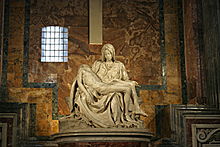 Michelangelo's Pietà is one of the Vatican's best known artworks.
Michelangelo's Pietà is one of the Vatican's best known artworks. Main article: Culture of Vatican City
Main article: Culture of Vatican CityVatican City is home to some of the most famous art in the world. St. Peter's Basilica, whose successive architects include Bramante, Michelangelo, Giacomo della Porta, Maderno and Bernini is a renowned work of Renaissance architecture. The Sistine Chapel is famous for its frescos, which include works by Perugino, Domenico Ghirlandaio and Botticelli as well as the ceiling and Last Judgement by Michelangelo. Artists who decorated the interiors of the Vatican include Raphael and Fra Angelico.
The Vatican Library and the collections of the Vatican Museums are of the highest historical, scientific and cultural importance. In 1984, the Vatican was added by UNESCO to the List of World Heritage Sites; it is the only one to consist of an entire state.[56] Furthermore, it is the only site to date registered with the UNESCO as a centre containing monuments in the "International Register of Cultural Property under Special Protection" according to the 1954 Hague Convention for the Protection of Cultural Property in the Event of Armed Conflict.[56]
Infrastructure
Transport
Main article: Transport in Vatican CityVatican City has a reasonably well developed transport network considering its size (consisting mostly of a plaza and walkways). As a country that is 1.05 kilometres (0.6 mi) long and 0.85 kilometres (0.5 mi) wide,[57] it has a small transportation system with no airports or highways. There is one heliport and a standard gauge railway connected to Italy's network at Rome's Saint Peter's station by an 852 metres (932 yd) long spur, only 300 metres (328 yd) of which is within Vatican territory.[58]
Pope John XXIII was the first Pope to make use of this railway, and Pope John Paul II used it as well, albeit very rarely. The railway is mainly used to transport freight.[58] As Vatican City has no airports (it is one of the few independent states in the world without one, except for the aforementioned heliport), it is served by the airports that serve the city of Rome, within which the Vatican is located, namely: Leonardo da Vinci-Fiumicino Airport and to a lesser extent, Ciampino Airport, which both serve as the departure gateway for the Pope's international visits.[58]
Communications
The City is served by an independent, modern telephone system,[59] the Vatican Pharmacy, and post office. The postal system was founded on 11 February 1929, and two days later became operational. On 1 August, the state started to release its own postal stamps, under the authority of the Philatelic and Numismatic Office of the Vatican City State.[60] The City's postal service is sometimes recognised as "the best in the world"[61] and mail has been noted to get to its target before the postal service in Rome.[61]
The Vatican also controls its own Internet TLD, which is registered as (.va). Broadband service is widely provided within Vatican City. Vatican City has also been given a radio ITU prefix, HV, and this is sometimes used by amateur radio operators.
Vatican Radio, which was organised by Guglielmo Marconi, broadcasts on short-wave, medium-wave and FM frequencies and on the Internet.[62] Its main transmission antennae are located in Italian territory. Television services are provided through another entity, the Vatican Television Center.[63]
L'Osservatore Romano is the multilingual semi-official newspaper of the Holy See. It is published by a private corporation under the direction of Roman Catholic laymen but reports on official information. However, the official texts of documents are in the Acta Apostolicae Sedis, the official gazette of the Holy See, which has an appendix for documents of the Vatican City State.
Vatican Radio, the Vatican Television Center, and L'Osservatore Romano are organs not of the Vatican State but of the Holy See, and are listed as such in the Annuario Pontificio, which places them in the section "Institutions linked with the Holy See", ahead of the sections on the Holy See's diplomatic service abroad and the Diplomatic Corps accredited to the Holy See, after which is placed the section on the State of Vatican City.
Crime
Main article: Crime in Vatican CityIn accordance with Article 22 of the 1929 Lateran Treaty between the Holy See and Italy, the Italian government, when requested by the Holy See, handles the prosecution and detention of criminal suspects, at the expense of the Vatican.[18] Capital punishment was envisaged in the legislation adopted in 1929 on the basis of Italian law, but the Vatican state never exercised it and abolished it in 1969.
See also
- Outline of Vatican City
- Index of Vatican City-related articles
- List of diplomatic missions of the Holy See
- List of Popes
- Music of Vatican City
- Passetto di Borgo
- The Vatican Today News Portal
References
Bibliography
- Morley, John. 1980. Vatican diplomacy and the Jews during the Holocaust, 1939–1943. New York : KTAV Pub. House. ISBN 0870687018
- Nichols, Fiona (1 August 2006). Rome and the Vatican. New Holland Publishers. pp. 85–. ISBN 9781845375003. http://books.google.com/books?id=S-TekVnvyx4C&pg=PA85. Retrieved 4 March 2010.
- Chadwick, Owen. 1988. Britain and the Vatican During the Second World War. Cambridge University Press
- Kent, Peter. 2002. The Lonely Cold War of Pope Pius XII: The Roman Catholic Church and the Division of Europe, 1943–1950. Ithaca: McGill-Queen's University Press. ISBN 0-7735-2326-X
- Ricci, Corrado. “Vatican: Its History Its Treasures” Contributor Ernesto Begni. 2003 Published by Kessinger Publishing, ISBN 0766139417, ISBN 9780766139411
 This article incorporates text from a publication now in the public domain: Herbermann, Charles, ed (1913). Catholic Encyclopedia. Robert Appleton Company.
This article incorporates text from a publication now in the public domain: Herbermann, Charles, ed (1913). Catholic Encyclopedia. Robert Appleton Company.
Footnotes
- ^ Visitors and tourists are not permitted to drive inside the Vatican without specific permission, which is normally granted only to those who have business with some office in the Vatican.
Notes
- ^ Vatican City State homepage
- ^ Treaty between the Holy See and Italy, article 26.
- ^ Vatican City is a city-state
- ^ In accordance with paragraph 2 of the Legge sulle fonti del diritto of 7 June 1929, all laws and regulations of the state are published in the Italian-language Supplemento per le leggi e disposizioni dello Stato della Città del Vaticano attached to the Acta Apostolicae Sedis. The text of the first seven items published in that supplement is given here. While the state itself uses only Italian, many other languages are used by institutions situated within the state, such as the Holy See, the Pontifical Swiss Guard, and the Pontifical Academy of Sciences. The Holy See uses Latin as an official language and French as a diplomatic language; in addition, its Secretariat of State uses English, German, Italian, Polish, Portuguese and Spanish. The Swiss Guard, in which commands on parade are given in German, also uses French and Italian in all its official ceremonies. The semi-official Holy See newspaper L'Osservatore Romano uses English, French, German, Italian, Malayalam, Polish, Portuguese and Spanish. Vatican Radio uses 40 languages, including Albanian, Amharic, Arabic, Armenian, Byelorussian, Bulgarian, Chinese, Croatian, Czech, Esperanto, English, Filipino, French, German, Hindi, Hungarian, Italian, Latvian, Lithuanian, Malayalam, Polish, Portuguese, Rumanian, Russian, Slovak, Slovenian, Somali, Spanish, Swahili, Tamil, Tigrigna, Ukrainian, and Vietnamese.
- ^ http://www.vatican.va/holy_father/paul_vi/apost_constitutions/documents/hf_p-vi_apc_19670815_regimini-ecclesiae-universae_it.html
- ^ a b c d "Holy See (Vatican City)". CIA—The World Factbook. https://www.cia.gov/library/publications/the-world-factbook/geos/vt.html. Retrieved 9 July 2011.
- ^ a b "catholic-pages.com". catholic-pages.com. http://www.catholic-pages.com/vatican/vatican_city.asp. Retrieved 9 July 2011.
- ^ "Internet portal of Vatican City State". Vatican City State. http://www.vaticanstate.va/EN/State_and_Government/StateDepartments/index.htm. Retrieved 9 July 2011.
- ^ Holy See (Vatican City), The World Factbook, CIA. Retrieved 1 July 2010.
- ^ Since 1 January 2002. www.vatican.va Holy See Press office – General Information. Retrieved 23 October 2009.
- ^ Before 2002, the Vatican lira (on par with the Italian lira)
- ^ ITU-T assigned code 379 to Vatican City. However, Vatican City is included in the Italian telephone numbering plan and uses the Italian country code 39, followed by 06 (for Rome) and 698.
- ^ "Homepage of Vatican City State". Vaticanstate.va. http://www.vaticanstate.va/EN/homepage.htm. Retrieved 15 October 2010.
- ^ "Stato della Città del Vaticano" is the name used in the state's founding document, the Treaty between the Holy See and Italy, article 26.
- ^ "Vatican City State". Vatican City Government. http://www.vaticanstate.va/EN/homepage.htm. Retrieved 28 November 2007.
- ^ "The Vatican to go carbon neutral". United Press International. 13 July 2007. http://www.physorg.com/news103554442.html. Retrieved 12 September 2009.
- ^ "Vatican (search)". Online Dictionary. http://dictionary.reference.com/browse/Vatican. Retrieved 28 November 2007.
- ^ a b c d Treaty between the Holy See and ItalyPDF
- ^ a b Excerpt of extraterritorial jurisdiction as per the Lateran Treaty of 1929:
- Article 13
- Italy recognizes the full ownership of the Holy See over the patriarchal Basilicas of St. John Lateran, Sta. Maria Maggiore, and St. Paul, with their annexed buildings.
- The State transfers to the Holy See the free management and administration of the said Basilica of St. Paul and its dependent Monastery, also paying over to the Holy See all monies representing the sums set aside annually for that church in the budget of the Ministry of Education.
- It is also understood that the Holy See shall remain the absolute owner of the edifice of S. Callisto, adjoining Sta. Maria in Trastevere.
- Article 14
- Italy recognizes the full ownership by the Holy See of the Papal Palace of Castel Gandolfo, together with all endowments, appurtenances, and dependencies thereof, which are now already in the possession of the Holy See, and Italy also undertakes to hand over, within six months after the coming into force of the present Treaty, the Villa Barberini in Castel Gandolfo, together with all endowments, appurtenances, and dependencies thereof.
- In order to round off the property situated on the northern side of the Janiculum Hill, belonging to the Sacred Congregation of Propaganda Fide and to other ecclesiastical institutions, which property faces the Vatican Palaces, the State undertakes to transfer to the Holy See or other bodies appointed by it for such purpose, all real estate belonging to the State or to third parties existing in that area. The properties belonging to the said Congregation and to other institutions and those to be transferred being marked on the annexed map.
- Finally, Italy shall transfer to the Holy See, as its full and absolute property, the Convent buildings in Rome attached to the Basilica of the Twelve Holy Apostles and to the churches of San Andrea della Valle and S. Carlo ai Catinari, with all annexes and dependencies thereof, and shall hand them over within one year after the entry into force of the present Treaty, free of all occupants.
- Article 15
- The property indicated in Article 13 hereof and in paragraphs (1) and (2) of Article 14, as well as the Palaces of the Dataria, of the Cancelleria, of the Sacred Congregation of Propaganda Fide in the Piazza di Spagna of the S. Offizio with its annexes, and those of the Convertendi (now the Congregation of the Eastern Church) in Piazza Scossacavalli, the Vicariato, and all other edifices in which the Holy See shall subsequently desire to establish other offices and departments although such edifices form part of the territory belonging to the Italian State, shall enjoy the immunity granted by International Law to the headquarters of the diplomatic agents of foreign States. Similar immunity shall also apply with regard to any other churches (even if situated outside Rome) during such time as, without such churches being open to the public, the Supreme Pontiff shall take part in religious ceremonies celebrated therein.
- Article 16
- The property mentioned in the three preceding Articles, as also that used as headquarters of the following Papal institutions—the Gregorian University, the Biblical, Oriental, and Archaeological Institutes, the Russian Seminary, the Lombard College, the two Palaces of St. Apollinaris and the Home of the Retreat of the Clergy dedicated to St. John and St. Paul—shall never be subject to charges or to expropriation for reasons of public utility, save by previous agreement with the Holy See, and shall be exempt from any contribution or tax, whether ordinary or extraordinary and payable to the State or to any other body.
- It shall be permissible for the Holy See to deal with all buildings above mentioned or referred to in the three preceding Articles as it may deem fit, without obtaining the authorisation or consent of the Italian governmental, provincial, or communal authority, which authorities may in this regard rely entirely on the high artistic traditions of the Roman Catholic Church.
- ^ "Map of Vatican City". www.saintpetersbasilica.org. http://www.saintpetersbasilica.org/vaticancity-map.htm. Retrieved 11 October 2009.
- ^ "Al Pellegrino Cattolico: The Vatican Gardens". 2008 Al Pellegrino Cattolico s.r.l. Via di Porta Angelica 81\83 (S.Pietro) I- 00193 Roma, Italy. http://www.pellegrinocattolico.com/ctv/gardens.htm. Retrieved 21 November 2008.
- ^ a b "Official Vatican City State Website: A Visit to the Vatican Gardens". 2007–08 Uffici di Presidenza S.C.V.. http://www.vaticanstate.va/EN/Monuments/The_Vatican_Gardens/. Retrieved 21 November 2008.
- ^ Lanciani, Rodolfo (1892). Pagan and Christian Rome Houghton, Mifflin.
- ^ Tacitus, The Histories, II, 93, translation by Clifford H. Moore (The Loeb Classical Library, first printed 1925)
- ^ Columbia Encyclopedia[dead link], Sixth Edition, 2001–2005
- ^ Chadwick, 1988, p. 222
- ^ Chadwick, 1988, pp. 222–32
- ^ Chadwick, 1988, pp. 232–36
- ^ Chadwick, 1988, pp. 236–44
- ^ Chadwick, 1988, pp. 244–45
- ^ "Vatican City (Politics, government, and taxation)". Nations Encyclopedia. http://www.nationsencyclopedia.com/economies/Europe/Vatican-City-POLITICS-GOVERNMENT-AND-TAXATION.html. Retrieved 28 November 2007.
- ^ "Vatican City". Catholic-Pages.com. http://www.catholic-pages.com/vatican/vatican_city.asp. Retrieved 4 March 2007.
- ^ Pontificalis Domus, 3
- ^ The site Hereditary Officers of the Papal Court continues to present these functions and titles as still in use, several decades after their abolition.
- ^ Vatican Diplomacy, Catholic-Pages.com, retrieved 15 Mar. 2007
- ^ One of the titles of the Pope listed in the Annuario Pontificio is "Sovereign of Vatican City State" (page 23* in recent editions).
- ^ Code of Canon Law, canon 361 and Code of Canons of the Eastern Churches, canon 48
- ^ "International postal code: SCV-00120." www.vatican.va Holy See Press office – General Information. Retrieved 23 October 2009.
- ^ a b "Vatican City Today". Vatican City Government. http://www.vaticanstate.va/EN/State_and_Government/History/Vatican_City_today.htm. Retrieved 28 November 2007.
- ^ The Holy See and Diplomacy, Foreign and Commonwealth Office
- ^ a b Vatican City State: Participation in International Organizations
- ^ See also appendix at end of Bilateral Relations of the Holy See
- ^ This is distinct from the budget of the Holy See, which is supported financially by a variety of sources, including investments, real estate income, and donations from Catholic individuals, dioceses, and institutions; these help fund the Roman Curia (Vatican bureaucracy), diplomatic missions, and media outlets. Moreover, an annual collection taken up in dioceses and direct donations go to a non-budgetary fund known as Peter's Pence, which is used directly by the Pope for charity, disaster relief and aid to churches in developing nations.
- ^ "Holy See (Vatican City): Economy". CIA – The World Factbook. https://www.cia.gov/library/publications/the-world-factbook/geos/vt.html. Retrieved 10 October 2010.
- ^ Seán P. O'Malley (28 September 2006). "A Glimpse Inside the Vatican & Msgr. Robert Deeley’s Guest Post". http://www.cardinalseansblog.org/?p=232. Retrieved 30 January 2008.
- ^ "Agreements on monetary relations (Monaco, San Marino, the Vatican and Andorra)". Activities of the European Union: Summaries of legislation. http://europa.eu/legislation_summaries/economic_and_monetary_affairs/institutional_and_economic_framework/l25040_en.htm. Retrieved 23 February 2007.
- ^ "Benedict Vatican euros set for release". Catholic News. 21 April 2006. http://www.cathnews.com/news/604/100.php. Retrieved 23 February 2007.[dead link]
- ^ Christian Telegraph: Holy See's budget shortfall shrinks in 2008. Note that the report quoted deals mainly with the revenues and expenses of the Holy See and mentions only briefly the finances of Vatican City.
- ^ "CIA – The World Factbook – Holy See (Vatican City)". Cia.gov. https://www.cia.gov/library/publications/the-world-factbook/geos/vt.html. Retrieved 28 March 2010.
- ^ The Vatican City State appendix to the Acta Apostolicae Sedis is entirely in Italian.
- ^ United Nations High Commissioner for Refugees (7 June 1992). "Law on Citizenship and Residence, 7 June 1992". Unhcr.org. http://www.unhcr.org/refworld/category,LEGAL,,LEGISLATION,VAT,3ae6b52f10,0.html. Retrieved 15 October 2010.
- ^ "Cittadinanza vaticana". Vatican.va. 31 December 2001. http://www.vatican.va/news_services/press/documentazione/documents/sp_ss_scv/informazione_generale/cittadinanza_it.html. Retrieved 15 October 2010.
- ^ "Vatican citizenship". Holy See Press Office. http://www.vatican.va/news_services/press/documentazione/documents/sp_ss_scv/informazione_generale/cittadini-vaticani_en.html. Retrieved 3 December 2006.
- ^ "Law on Citizenship, Residency and Access to the Vatican". VIS – Vatican Information Service. 1 March 2011. http://visnews-en.blogspot.com/2011/03/law-on-citizenship-residency-and-access.html. Retrieved 1 March 2011.
- ^ a b c d e f "Law Now Allows for Vatican Residents: 1929 Code Replaced". ZENIT. Innovative Media, Inc.. 2 March 2011. http://www.zenit.org/article-31900?l=english. Retrieved 2 March 2011.
- ^ a b "Vatican City – UNESCO World Heritage Centre". whc.unesco.org. http://whc.unesco.org/en/list/286. Retrieved 10 October 2009.
- ^ "Holy See – State of the Vatican City". Vatican Papal Conclave. http://www.vatican.va/news_services/press/documentazione/documents/sp_ss_scv/informazione_generale/sp_ss_scv_info-generale_en.html. Retrieved 28 November 2007.
- ^ a b c Vatican City State Railway "Railways of the World". Sinfin.net. http://www.sinfin.net/railways/world/vatican/vaticanrail.html#Origini Vatican City State Railway. Retrieved 8 August 2006.
- ^ On call 24/7: Vatican phone system directs thousands of call each day, 24 July 2006.
- ^ "The Early Definitives". Vatican Philatelic Society. Archived from the original on 11 December 2007. http://web.archive.org/web/20071211191109/http://www.vaticanphilately.org/vc.htm. Retrieved 28 November 2007.
- ^ a b Baker, Al (27 June 2004). "Hail Marys Not Needed: Vatican Mail Will Deliver". New York Times. http://query.nytimes.com/gst/fullpage.html?res=950CEFDE1738F934A15755C0A9629C8B63&n=Top/News/World/Countries%20and%20Territories/Vatican%20City. Retrieved 28 November 2007.
- ^ "Vatican Radio – Index". Vatican.va. 2 September 2005. http://www.vatican.va/news_services/radio/index.htm. Retrieved 6 May 2009.
- ^ "Vatican Television Center – Index". Vatican.va. http://www.vatican.va/news_services/television/index.htm. Retrieved 6 May 2009.
External links
- Vatican City State—official website
- Chief of State and Cabinet Members
- Vatican City at the Open Directory Project
- History of Vatican City: Primary Documents
- Agreement Between the Italian Republic and the Holy See, 18 February 1984
- Map of Vatican City
- The Vatican as a Free Society by Carlo Lottieri
- Walls of Rome
Wikimedia Atlas of Vatican City
- World Heritage Site
- Vatican City Live Webcam
 OpenStreetMap has geographic data related to Vatican City
OpenStreetMap has geographic data related to Vatican City
Vatican City topics General Demographics · Languages · Military (Swiss Guard, Corpo della Gendarmeria) · Economy (Banking) · Transport · Tourism · Internet domain · Newspapers · Radio · TelevisionHistory Geography Politics Law · Government · Foreign relations · Elections · Political parties · Law enforcement · LGBT rights · Fundamental Law of Vatican City StateCulture Science Sports  Vatican Portal
Vatican Portal  Catholicism Portal
Catholicism PortalPapal symbols and rituals Apostolic Palace · Camauro · Coat of arms · Conclave · Coronation · Fanon · Flabellum · Holy See · Inauguration · Mitre · Mozzetta · Papal Cross · Pallium · Popemobile · Regalia and insignia · Ring of the Fisherman · Basilica of St. John Lateran · St. Peter's Basilica · Saint Peter's Square · Sedia gestatoria · Sistine Chapel · Tiara · Vatican CityCoordinates: 41°54′14″N 12°27′11″E / 41.904°N 12.453°E
International membership Member nations Andorra · Angola · Bolivia · Brazil · Cape Verde · Chile · Colombia · Costa Rica · Côte d'Ivoire · Cuba · Dominican Republic · East Timor · Ecuador · El Salvador · France · Guatemala · Guinea-Bissau · Haiti · Honduras · Italy · Mexico · Moldova · Monaco · Mozambique · Nicaragua · Panama · Paraguay · Peru · Philippines · Portugal · Romania · San Marino · São Tomé and Príncipe · Senegal · Spain · Uruguay · VenezuelaPermanent observers Official languages Monarchies List of current sovereign monarchs · List of current constituent monarchs By continent By country Antigua and Barbuda · Australia · Andorra · The Bahamas · Bahrain · Barbados · Belize · Belgium · Bhutan · Brunei · Cambodia · Canada · Denmark · Grenada · Jamaica · Japan · Jordan · Kuwait · Liechtenstein · Lesotho · Luxembourg · Malaysia · Monaco · Morocco · Netherlands · New Zealand · Norway · Oman · Papua New Guinea · Qatar · Spain · Saint Kitts and Nevis · Saint Lucia · Saint Vincent and the Grenadines · Saudi Arabia · Solomon Islands · Swaziland · Sweden · Thailand · Tonga · Tuvalu · United Arab Emirates · United Kingdom · Vatican CityBy type Italics indicate Commonwealth realms, which each share the same person as head of state. History of Europe Prehistoric Europe Classical Antiquity Classical Greece · Roman Republic · Hellenistic period · Roman Empire · Late Antiquity · Early Christianity · Crisis of the 3rd century · Fall of the Roman EmpireMiddle Ages Early Middle Ages · Migration Period · Byzantine Empire · Christianization · Kievan Rus · High Middle Ages · Holy Roman Empire · Crusades · Feudalism · Late Middle Ages · Hundred Years' War · RenaissanceEarly Modern Europe Reformation · Age of Discovery · Baroque · Thirty Years' War · Absolutism · Ottoman Empire · Portuguese Empire · Spanish Empire · Early modern France · Polish–Lithuanian Commonwealth · Swedish Empire · Dutch Republic · British Empire · Habsburg Empire · Russian EmpireModern history See also Categories:- Vatican City
- Capitals in Europe
- Catholic pilgrimage sites
- Christianity in Europe
- City-states
- Countries that are enclaves of Italy
- Current monarchies
- European countries
- Geography of Rome
- Holy cities
- Italian-speaking countries
- Landlocked countries
- Prince-Bishoprics
- States and territories established in 1929
- Theocracies
- World Heritage Sites in Vatican City
- Enclaves
Wikimedia Foundation. 2010.

![Location of Vatican City (green)in Europe (dark grey) — [Legend]](/pictures/enwiki/50/250px-Location_Vatican_City_Europe.png)


